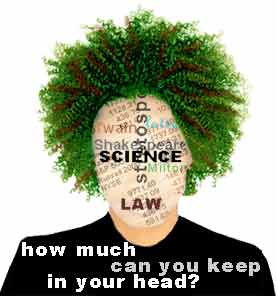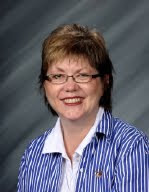Saturday, July 18, 2009
Wednesday, July 15, 2009
Information Overload

When sending someone a meeting request, phrase the subject and location so they make sense to all parties to the meeting. For instance, if Jill sends Jack a calendar item that says "Meeting with Jack - my office" it will be quite meaningless when viewed by Jack on his calendar. Always include both names and an absolute address - as in "Jack/Jill on budget proposal - Jill's office".
Excellent. This is clear, concise messaging. If you ever have to send me a 'meeting request,' you probably should know that my 'absolute address' is THE LIBRARY. By the way, did you know that Jack had a calendar? That piece of information had previously eluded me.
We all know that one website leads to another, and before I knew it, I arrived at Information Overload Killer, a site selling the solution to all my problems. With this product, I can do more than reduce information overload, I can kill it!
But first I decided to take their test to see if my money would be well-spent. Question One: Are you exasperated and at your wits end? Question Two: Are you frustrated? Question Three: Are you overwhelmed? Question Four: Are you ready to put your fist through the computer screen? yes, yes, yes, Yes!
Let me get my debit card. Scrolling down to the end of the screen, I was asked what I would expect to pay for my resurrected sanity -- $250? $175? $97? $52? Information this good is hard to come by--I'd spring for any or all of the above. The actual price? Just $10. WHAT? TEN BUCKS? You can't get valuable, extensive information for a pittance. Back to the virtual drawing board. CLICK! . . . . Thank goodness our students never experience this phenomenon!
Tuesday, July 7, 2009
Tolerance!

Unfortunately, many school environments provide little in the way of education and enlightenment on an issue affecting 5% —many sources say up to 10%--of our student body. Though acceptance of gay and lesbian students has improved, these students continue to be subjected to harassment that is both verbal and physical. The Gay, Lesbian and Straight Education Network (GLSEN) found that “9 out of 10 secondary school principals report that their students have been harassed.
If 90% of gay and lesbian students have reported being harassed in school, it is important to look at the outcomes of this abuse. Statistical evidence provides overwhelming insight into the suffering of gay and lesbian students. Consider the following statistics from Youth Pride, Inc. (2009):
· 36.5 % of GLB youth grades 9-12 have attempted suicide --20.5% of those attempts resulting in medical care.
· 84% of LGBT students report being verbally harassed (name calling, threats, etc.) because of their sexual orientation.
· 91.5% of LGBT students report hearing homophobic remarks, such as “faggot,” “dyke” or the expression “that’s so gay” frequently or often.
· 82.9% of LGBT students report that faculty or staff never intervened or intervened only some of the time when homophobic remarks were made.
These are only a few of the disturbing statistics related to gay teens.
They seem overwhelming; however, many schools are beginning to address the issue. One of the most encouraging changes is the growing number of Gay Straight Alliances in high schools and middle schools.
Of course, before we can implement these changes, we as educators must examine our own biases and prejudices. If we are truly committed to all of our students, we will strive to overcome any behavior that marginalizes any of our students. As we sensitize ourselves and educate ourselves, our ability to open up and embrace our students of diversity will increase. We can learn to stand beside all of our students, even those that are gay or lesbian and authentically advocate for their success in school as well as in life.
Tuesday, June 30, 2009
"Only the Educated Are Free" --Epictetus
"Eighty-five percent of all juveniles who interface with the juvenile court system are functionally illiterate. More than 60 percent of all prison inmates are functionally illiterate.Penal institution records show that inmates have a 16% chance of returning to prison if they receive literacy help, as opposed to 70% who receive no help.Illiteracy and crime are closely related. The Department of Justice states, 'The link between academic failure and delinquency, violence, and crime is welded to reading failure.' Over 70% of inmates in America's prisons cannot read above a fourth grade level."
The library was modest to say the least. There are no computers and there is no internet access in the prison. Many of the books were old and ragged, and Glen told us that they are always in need of more books and are happy to take donations. He said that especially during the winter months, the library is very busy.
After we left the prison, I was struck by the irony of the situation. Is there a need for prison libraries? Can we help by donating books and materials? The answer, of course, is yes. And yet, as we look at the literacy statistics of those who are incarcerated--60% are functionally illiterate, I couldn't help but wonder how many prisoners never use the library because of their inability to read.
Back on the bus, various conversations broke out about the prison experience. The general consensus? We were overwhelmed by the feeling that even as temporary volunteers we had to give up every basic freedom that we take for granted. But more importantly, we concluded that our mandate as educators is clear. We must work relentlessly, and intervene whenever necessary, to empower our students by giving them the precious gift of literacy.
If you would like to donate any books, used or new, just e-mail me, and I'll give the information you'll need to send the books to the prison.
Wednesday, June 24, 2009
The Literate American
A. Paul Revere's Ride
C. A domesticated bird is more valuable than birds in the wild.
1. B; 2. C; 3. B; 4. A; 5. B
Wednesday, June 17, 2009
Essential Questions

--Kermit, the Frog
Theodore Sizer, Dean of Brown University School of Education, conceived of the use of essential questions as a way to improve the knowledge and skills of high school students in his book Horace’s Compromise published in 1984. Using essential questions in teaching and learning has become one of the cornerstones of educational reform.
What do we mean by using essential questions? Jamie McKenzie, a proponent of educational reform and technology integration and the creator of the research model, the Research Cycle, says that “the question is the answer.” As editor of the online educational technology journal, From Now On, McKenzie says this:
"Essential questions reside at the top of Bloom's Taxonomy. They require
students to EVALUATE (make a thoughtful choice between options, with the choice based upon clearly stated criteria), to SYNTHESIZE (invent a new or different
version) or to ANALYZE (develop a thorough and complex understanding through
skillful questioning).Essential questions spark our curiosity and sense of
wonder. They derive from some deep wish to understand something which matters to us.”
How do you think the Puritans would incorporate technology into their lives?
What would the Puritans think of the powerful evangelical right’s
involvement in politics today?
From what you know, what would be the best
and the worst things about being a Puritan?These are examples of jumping off points that will lead to more questions and take our learning from a linear to a cyclical experience. Essential questions like these allow us to make connections to our own lives. If we pursue a study of this kind, we come to perceive Puritans as real human beings. Our understanding is deepened and spurs more curiosity.
Clifford and Friesen of the Galileo Educational Network point out that an essential question is “always poised at the boundary of the known and the unknown. It engages the imagination in significant ways. Attempts to answer an essential question open up mysteries that successively reveal themselves the more we come to ‘know’.”
Teaching and learning strategies that prompt us to become life-long learners who reach for insight and profound meaning, are worth the effort. As promoters of information literacy, librarians and teachers can help students use essential questions as higher order thinking skills that will result in meaningful, authentic learning.


